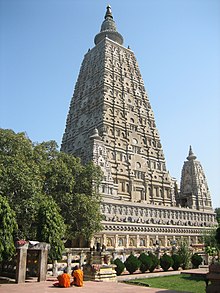| Bodh Gaya | |
| | |
| Coordinates | 24°41′42″N 84°59′29″E / 24.695102°N 84.991275°E |
| Country | |
| State | Bihar |
| District(s) | Gaya |
| Population | 30,883 (2001[update]) |
| Time zone | IST (UTC+5:30) |
Bodh Gaya or Bodhgaya (Hindi: बोधगया) is a city in Gaya district in the Indian state of Bihar. It is famous for being the place of Gautama Buddha's attainment of nirvana (Enlightenment).
Historically, it was known as the Bodhimanda (ground around the Bodhi-tree), Uruvela, Sambodhi, Vajrasana and Mahabodhi. The name Bodh Gaya did not come into use until the 18th century. The main monastery of Bodhgaya used to be called the Bodhimanda-vihāra (Pali). Now it is called the Mahabodhi Temple.
For Buddhists, Bodh Gaya is the most important of the main four pilgrimage sites related to the life of Gautama Buddha, the other three being Kushinagar, Lumbini, and Sarnath. In 2002, Mahabodhi Temple, located in Bodh Gaya, became a UNESCO World Heritage Site.
The surrounding town, by contrast, is dusty, noisy and somewhat polluted, due in large part to the large numbers of pilgrims and tourists who visit there. A new development plan has been proposed to "ensure a sustainable and prosperous future" for Bodh Gaya, but has become controversial because such a plan may require the relocation of whole neighborhoods.
History

| Pilgrimage to Buddha's Holy Sites |
 |
| The Four Main Sites |
|---|
| Lumbini · Bodh Gaya Sarnath · Kushinagar |
| Four Additional Sites |
| Sravasti · Rajgir Sankissa · Vaishali |
| Other Sites |
| Patna · Gaya · Kosambi Kapilavastu · Devadaha Kesariya · Pava Nalanda · Vikramshila · Varanasi |
| Later Sites |
| Sanchi · Mathura |
According to Buddhist traditions, circa 500 BC Prince Gautama Siddhartha, wandering as an ascetic, reached the sylvan banks of Falgu River, near the city of Gaya. There he sat in meditation under a bodhi tree (Ficus religiosa). After three days and three nights of meditation, Siddharta attained enlightenment and insight, and the answers that he had sought. He then spent seven weeks at seven different spots in the vicinity meditating and considering his experience. After seven weeks, he travelled to Sarnath, where he began teaching Buddhism.
Disciples of Gautama Siddhartha began to visit the place where he had gained enlightenment during the full moon in the month of Vaisakh (April-May), as per the Hindu calendar. Over time, the place became known as Bodh Gaya, the day of enlightenment as Buddha Purnima, and the tree as the Bodhi Tree.
The history of Bodh Gaya is documented by many inscriptions and pilgrimage accounts. Foremost among these are the accounts of the Chinese pilgrims Faxian in the 5th century and Xuanzang in the 7th century. The area was at the heart of a Buddhist civilization for centuries, until it was conquered by Turkish armies in the 13th century.
Mahabodhi Temple
The complex, located about 96 kilometres from Patna, at 24°41′43″N 84°59′38″E / 24.69528°N 84.99389°E, contains the Mahabodhi Temple with the diamond throne (called the Vajrasana) and the holy Bodhi tree. This tree was originally a sapling of the Sri Maha Bodhi tree in Sri Lanka, itself grown from a sapling of the original Bodhi tree.
It is believed that 250 years after the Enlightenment of the Buddha, Emperor Asoka visited Bodh Gaya. He is considered to be the founder of the original Mahabodhi temple. It consisted of an elongated spire crowned by a miniature stupa and a chhatravali on a platform. A double flight of steps led up to the platform and the upper sanctum. The mouldings on the spire contained Buddha images in niches. Some historians believe that the temple was constructed or renovated in the 1st century during the Kushan period. With the decline of Buddhism in India, the temple was abandoned and forgotten, buried under layers of soil and sand.
The temple was later restored by Sir Alexander Cunningham as part of his work for the British Archaeological Society in the late 19th century. In 1883, Cunningham along with J. D. Beglar and Dr Rajendralal Miitra painstakingly excavated the site. Extensive renovation work was carried out to restore Bodh Gaya to its former glory.
Other Buddhist temples
Kittisirimegha of Sri Lanka, a contemporary of Samudragupta, erected with the permission of Samudragupta, a Sanghārāma near the Mahābodhi-vihāra, chiefly for the use of the Singhalese monks who went to worship the Bodhi tree. The circumstances in connection with the Sanghārāma are given by Hiouen Thsang (Beal, op. cit., 133ff) who gives a description of it as seen by himself. It was probably here that Buddhaghosa met the Elder Revata who persuaded him to come to Ceylon.
Presently, several Buddhist temples and monasteries have been built by the people of Bhutan, China, Japan, Myanmar, Nepal, Sikkim, Sri Lanka, Taiwan, Thailand, Tibet and Vietnam in a wide area around the temple. These buildings reflect the architectural style, exterior and interior decoration of their respective countries. The statue of Buddha in the Chinese Temple is 200 years old and was brought from China. Japan's Nippon Temple is shaped like a pagoda. The Myanmar (Burmese) Temple is also pagoda shaped and is reminiscent of Bagan. The Thai Temple has a typical sloping, curved roof covered with golden tiles. Inside, the temple holds a massive and spectacular bronze statue of Buddha. Next to the Thai temple there is a recent 25 meter statue of Buddha located within a garden which has existed there for over 100 years. For Tibetan buddhism there are two temples.
Demographics
As of 2001[update] India census, Bodh Gaya had a population of 30,883. Males constitute 54% of the population and females 46%. Bodh Gaya has an average literacy rate of 51%, lower than the national average of 59.5%; with male literacy of 63% and female literacy of 38%. 18% of the population is under 6 years of age.
Transportation
Bihar State Tourism Development Corporation (Bihar Tourism) provides travel facility from state capital Patna to visit Bodh circuit (Bodhgaya, Rajgir, Nalanda, Vaishali, Kesaria, Lumbini, Kushinagar, Sarnath), Jain Circuit (Rajgir, Pawapuri) and Sikh Circuit in Bihar.






0 Comments:
Post a Comment